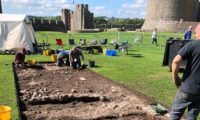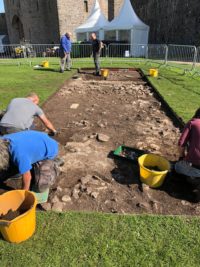 Archaeologists have discovered the remains of a house on the grounds of Pembroke Castle that is probably the house when the future King Henry VII was born. Previous aerial photography and a geophysical survey had found evidence of a possible building on the site and this two-week excavation was an exploratory dig to see if there really was something there worth pursuing. That question has been answered loud and clear.
Archaeologists have discovered the remains of a house on the grounds of Pembroke Castle that is probably the house when the future King Henry VII was born. Previous aerial photography and a geophysical survey had found evidence of a possible building on the site and this two-week excavation was an exploratory dig to see if there really was something there worth pursuing. That question has been answered loud and clear.
Just days into an initial dig, archaeologists have uncovered up to half a metre of the building’s walls – and they are yet to reach the main floor levels. One wall is a metre thick.
They have also unearthed so many slates and tiles that they are concluding it had a slate roof. Green-glazed ridge tiles have also been found, which suggest a particularly imposing building, while other finds include a curving stair from a spiral staircase.
James Meek, who is heading the excavation for the Dyfed Archaeological Trust, said such finds are already suggesting “a fairly showy building” inside of the outer walls of the castle.
It is about the size of two tennis courts, while the scale of the walls suggests a structure of a considerable height.
 The thick walls also map out a floor plan characteristic of a late medieval hall house you’d find in the later 15th century. That’s when the castle was granted to Jasper Tudor, Henry’s uncle. According to legend, little Henry Tudor was born in the 13th century tower of the 11th century castle, but then again, the arch-rival for the throne he would defeat so soundly, Richard III, was said the have been born with a full set of teeth and a tail, so yeah, there’s a lot of tall-taleism to sift through in accounts of rulers’ lives. Documentary evidence confirms that he was born at Pembroke Castle, but it’s far more likely he was born in a large, comfortable mansion on the grounds of his uncle Jasper’s castle than in the guard tower.
The thick walls also map out a floor plan characteristic of a late medieval hall house you’d find in the later 15th century. That’s when the castle was granted to Jasper Tudor, Henry’s uncle. According to legend, little Henry Tudor was born in the 13th century tower of the 11th century castle, but then again, the arch-rival for the throne he would defeat so soundly, Richard III, was said the have been born with a full set of teeth and a tail, so yeah, there’s a lot of tall-taleism to sift through in accounts of rulers’ lives. Documentary evidence confirms that he was born at Pembroke Castle, but it’s far more likely he was born in a large, comfortable mansion on the grounds of his uncle Jasper’s castle than in the guard tower.
Expressing surprise over how much of this structure has survived, Meek said: “It tells a very different story for how we think outer walls of castles were used in that later medieval period … it was always the thought that they [castles] were full of smaller timber buildings of lesser status than the rest of the court rooms and the administrative functions of the castle itself. Whereas here, you’ve got one high-status residential structure.”